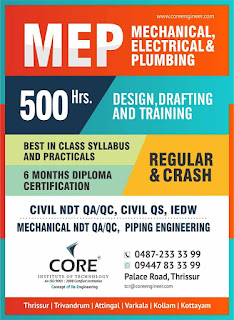Visual inspection
 Visual inspection is a common method of quality
control, data acquisition, and data analysis. Visual Inspection, used
in maintenance of facilities, mean inspection of equipment and structures using
either or all of raw human senses such as vision, hearing, touch and smell
and/or any non-specialized inspection equipment. Inspections requiring
Ultrasonic, X-Ray equipment, Infra-red, etc. are not typically regarded as
Visual Inspection as these Inspection methodologies require specialized
equipment, training and certification.
Visual inspection is a common method of quality
control, data acquisition, and data analysis. Visual Inspection, used
in maintenance of facilities, mean inspection of equipment and structures using
either or all of raw human senses such as vision, hearing, touch and smell
and/or any non-specialized inspection equipment. Inspections requiring
Ultrasonic, X-Ray equipment, Infra-red, etc. are not typically regarded as
Visual Inspection as these Inspection methodologies require specialized
equipment, training and certification.
Contents
- 1Quality
control
- 2Humorous
terminology
Quality control
A study of the visual inspection of small integrated
circuits found that the modal duration of eye fixations of trained
inspectors was about 200 ms. The most accurate inspectors made the fewest
eye fixations and were the fastest. When the same chip was judged more than
once by an individual inspector the consistency of judgment was very high
whereas the consistency between inspectors was somewhat less. Variation by a
factor of six in inspection speed led to variation of less than a factor of two
in inspection accuracy. Visual inspection had a false positive rate
of 2% and a false negative rate of 23%.
Humorous terminology
 To do an eyeball search is to look for
something specific in a mass of code or data with one's own eyes,
as opposed to using some sort of pattern matching software like grep or
any other automated search tool. Also known as vgrep or ogrep,
i.e., "visual/optical grep", and in the IBM mainframe
world as IEBIBALL. The most important application of eyeball
search / vgrep in software engineering is vdiff.
To do an eyeball search is to look for
something specific in a mass of code or data with one's own eyes,
as opposed to using some sort of pattern matching software like grep or
any other automated search tool. Also known as vgrep or ogrep,
i.e., "visual/optical grep", and in the IBM mainframe
world as IEBIBALL. The most important application of eyeball
search / vgrep in software engineering is vdiff.
In various disciplines it is also called the "eyeball
technique" or "eyeball method" (of data assessment).
"Eyeballing" is the most common and readily
available method of initial data assessment.
Experts in pattern recognition maintain that the
"eyeball" technique is still the most effective procedure for
searching arbitrary, possibly unknown structures in data.
No comments:
Post a Comment